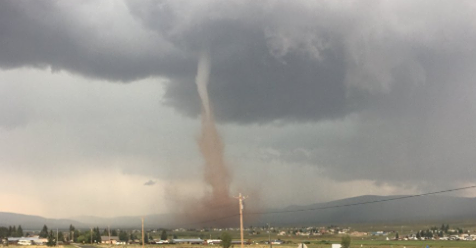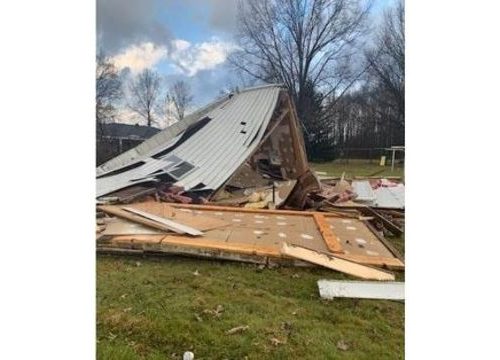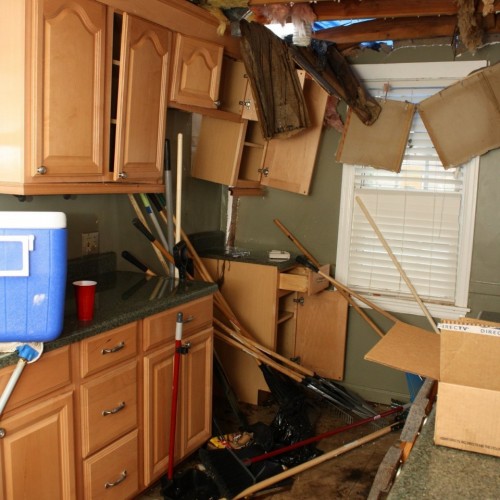When four EF3 tornadoes carved up hundreds of miles of Alabama forest and neighborhoods on March 25, thousands of people ran to their safe places to escape the roiling, wedge-shaped beasts. Five people were killed and dozens more injured in the storms in Alabama. The same system also dropped Georgia’s first EF4 tornado in a decade.
Despite the enormous damage and tornado tracks as long as 80 miles, the death toll was comparatively low — a testament to warnings with lead times of up to an hour in advance. There were also significant efforts by the media and emergency management to raise awareness and communicate the threat as well as the warnings.
The National Weather Service in Birmingham, which issued a majority of the warnings and conducted many post-storm surveys, compiled stories detailing how warnings and sheltering saved lives.
“We’ve spoken with numerous folks while out surveying damaged areas and are thrilled to hear so many successful sheltering stories,” tweeted the Birmingham office. “Folks, please let this serve as proof that being prepared saves lives!”
In Wellington, Ala., about 60 miles northeast of Birmingham, two adults and four children sought shelter in a small interior closet after receiving the tornado warning. The alert was issued at 2:23 p.m., allowing residents in the path roughly 30 minutes to get to a safe place.
The family’s home was obliterated. One car was tossed into what appears to be a living room wall, and another vehicle flipped upside down on the stoop.
Only the closet and a small structure surrounding it were left standing — the family inside later emerging unscathed.
In the same community, a group of 13 people survived in an underground storm cellar, the tornado passing directly over them.
One person died when a nearby mobile home was destroyed. This sadly reinforces the unfortunate truth that there is no safe place in a mobile home during a tornado. Whenever possible during severe weather, mobile homes should be evacuated for site-built, sturdy structures or an underground shelter.
That’s what a group of three did in Nanafalia, in Marengo County in western Alabama. The town was struck by an EF2 tornado. After receiving a phone call from their employer, who urged them to move up the road to a sturdy shelter, the trio relocated. The mobile home was demolished, with only cinder blocks remaining.
Twenty-two people at Precision Materials in Ohatchee hid from the same storm that struck Wellington, sheltering in a safe room after receiving a warning. All survived with no injuries.
Part of the success story stemmed from unusually long tornado warning polygons issued by the National Weather Service in Birmingham, meaning their warning boxes stretched much farther downwind than typical. This provided more advanced notice than usual.
“Given the environment we had last week and the likelihood of long-track tornadoes, once we latched onto the supercells, there was really no need to cut ourselves short in time or in space,” said Chris Darden, meteorologist in charge at the Weather Service in Birmingham, who coordinated the office’s strategy leading up to the event. “It was sort of a decision we made to get those warnings downstream to communicate as much as possible. Seconds matter in things like this, but the more minutes you can provide someone, even better.”
Darden emphasized that most of the communities hit were rural and that residents would need more time to relocate to a distant neighbor’s house or community shelter.
Much like with the March 17 tornado outbreak, Darden says, Alabama was spared what could have been a worse impact if the tornadoes had directly struck urban centers.
“I will be honest: We were somewhat fortunate,” Darden said. “When you go back and look at the tracks, we were fortunate that, particularly that southern one, a lot of that area it went through was the national forest — it was pretty rural. I’m not going to sugarcoat it. I have to imagine the injuries and, unfortunately, fatalities would have been a lot higher.”
Darden said that at least three dozen tornadoes touched down in Alabama in March, a record. He thinks it’s partly a product of the busy season and how judicious his office has been in conducting storm surveys, considering the likelihood of missed events during generations past.
“We’re better about getting out and surveying,” he said. “It’s hard to compare records in [the advanced radar] era versus 50 or 60 years ago, when we probably weren’t surveying F0s and F1s.”
His office still has a few additional areas of tornado damage to survey, so the numbers may rise.
The March 25 outbreak was the second “high risk” (Level 5) tornado outlook issued for Alabama in eight days, following a seven-year stretch in which the National Weather Service Storm Prediction Center had not issued any high-risk tornado outlooks for Alabama. Both tornado outbreaks were serious but very different. The former produced dozens of lower-end tornadoes, while the latter resulted in just a few tornadoes — but they were strong to violent and long-lived.
“A week [after the first outbreak] we were trying to communicate to the public,” said Darden, who briefed the governor and emergency management officials. “I said that we very likely won’t get 25 tornadoes statewide with this one — we may not get half that — but that the tornadoes that happen today will be on the ground for a lot higher amount of time and have a higher chance of killing people.”
Looking at the forecast ingredients, he knew that there would be only a couple of rotating thunderstorms but that those that formed could be volatile.
Overall, he’s glad that so many folks took the warnings seriously last week. For a time, he was worried that he and his team at the Weather Service office would have to take shelter, too.
“We got split at the office. … One tornado went north, one went south,” Darden said. “We did have to contact our backup office in Peachtree City [in Georgia] in case we had to shelter … but we realized the tornado wouldn’t come too close.”
They usually shelter if the tornado approaches within a mile or two. During that time, one office will back up another by taking over all operations, including issuing warnings and tracking storms.
“On the flip side,” he said, the EF4 tornado that hit Newnan, Ga., “came near Peachtree City, and we were on standby for them.”
In Alabama, arguably the most vulnerable state in the country for tornadoes, dangerous storms are a way of life. Even meteorologists aren’t immune. In 2019, the forecaster issuing tornado emergencies for a deadly twister in Lee County grew worried about relatives in the path of the storm, which killed 23 people.
“He’s trying to do his job and text parents, his mind’s kind of racing; you have a massive tornado heading right towards his family’s house,” Darden explained. “… I was dealing with the same thing last week, texting my wife but also dealing with [potentially moving to] shelter at the office.”
The house of James Spann, a beloved television meteorologist in Birmingham, was also hit.
“We kind of say we don’t have [just a] spring severe weather season,” Darden said. “It kind of starts mid-October and goes through mid-May or the end of May.”
And with another month and a half to go, Darden and his team are ready.
by Matthew Cappucci (2021, Apr 1) The Washington Post




